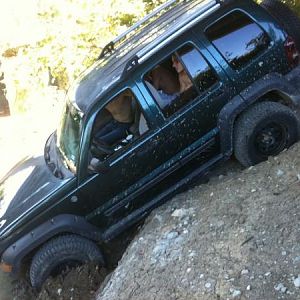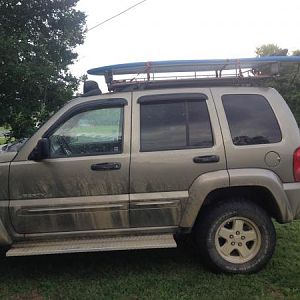so ive seen this black kk around town a couple times and i love the wheels and tires they have but im pretty sure there is no lift on it . what would be the biggest/best looking wheel/ offroad tire combo for my 11' liberty limited? im kinda new to the jeep world . thanks
You are using an out of date browser. It may not display this or other websites correctly.
You should upgrade or use an alternative browser.
You should upgrade or use an alternative browser.
best wheel tire combo?
- Thread starter tea eye
- Start date
Disclaimer: Links on this page pointing to Amazon, eBay and other sites may include affiliate code. If you click them and make a purchase, we may earn a small commission.
stock size wheels ( width and backspacing) and 245-70-16s
I'll have to say that bigger/ wider tires and wider "Stance" are for looks only.
They don't really give you more traction and wear out your suspension components prematurely.
As a youngster and new jeeper, you will be tempted to Just Empty Every Pocket on a cascade of modifications that all promise to fix the last problem you created with that last "upgrade".
You'll end up spending thousands on parts and hate the way it drives because you try to out do either the poser crowd or the ******** rockcrawlers.
Just get a quality mild (2.5") lift and some skinny AT tires.
Trust me on this.
They don't really give you more traction and wear out your suspension components prematurely.
As a youngster and new jeeper, you will be tempted to Just Empty Every Pocket on a cascade of modifications that all promise to fix the last problem you created with that last "upgrade".
You'll end up spending thousands on parts and hate the way it drives because you try to out do either the poser crowd or the ******** rockcrawlers.
Just get a quality mild (2.5") lift and some skinny AT tires.
Trust me on this.
You must be registered for see images
tjkj2002
Full Access Member
- Joined
- Dec 17, 2006
- Messages
- 10,612
- Reaction score
- 41
Yeah you need to do some more research on that one.I'd like to know how a bigger contact patch equals less traction.Guess those top fuel dragsters with 18" wide slicks are doing it all wrong.I'll have to say that bigger/ wider tires and wider "Stance" are for looks only.
They don't really give you more traction
Yeah you need to do some more research on that one.I'd like to know how a bigger contact patch equals less traction.Guess those top fuel dragsters with 18" wide slicks are doing it all wrong.
You should see how fast they are on 6 inch wide slicks
Counterintuitive, I know, but what works for dragsters doesn't translate into all regimes of driving. If dragster slicks have so much traction, why aren't they mandated to be on all vehicles like safety belts?
Expeditions West: Tire Selection for Expedition Travel
http://www.youtube.com/watch?v=deDhbZPuiJo
Expeditions West: Tire Selection for Expedition Travel
http://www.youtube.com/watch?v=deDhbZPuiJo
Last edited:
tjkj2002
Full Access Member
- Joined
- Dec 17, 2006
- Messages
- 10,612
- Reaction score
- 41
Bald tires have more traction on dry pavement then full tread tires,even the same size.It's all about the size of the contact patch.Sure a bigger contact patch spreads out the vehicle weight but not as much as one would think.Counterintuitive, I know, but what works for dragsters doesn't translate into all regimes of driving. If dragster slicks have so much traction, why aren't they mandated to be on all vehicles like safety belts?
Expeditions West: Tire Selection for Expedition Travel
Large tires vs Thin tires - YouTube
The only 2 reasons to ever run a narrow tire are ice traction and mpg's,that is it otherwise wider tires will always win in all other area's.
jankerson
Full Access Member
Yeah you need to do some more research on that one.I'd like to know how a bigger contact patch equals less traction.Guess those top fuel dragsters with 18" wide slicks are doing it all wrong.
Actually he was correct in a way....
Wider tires do help with pavement traction like on sports cars etc as they have more contact area with the road.
Also on sand because they will float on top, and really deep snow (Powder) with really wide tires, they will float on top also....
Also mud bogging, but that's not really normal, more on the extreme side needing really wide tires and speed to stay on top.
Now off roading on trails etc wider tires can hurt you in mud because they will just sit on top and spin instead of digging down and grabbing, takes a lot more for a wide tire to dig down and grab than a narrower tire. Also in normal loose dirt (like in a plowed field) you want a tire that will dig down and grab instead of sitting on top...
Same goes for wet snow (NOT powered) if the tire is too wide it will just sit on top and spin instead of digging down and grabbing like a narrower tire will.
There really isn't just one answer to all the questions, have to match the tires to the application, that's width and type of tire...
Depends on if the application needs a tire that will float or dig down and grab.... Wider tires for floating and narrower tires for digging down and finding traction.
There are tires developed for different conditions and surfaces so picking the tire that will work the best for what the person does with their vehicle is important.
And yes the really wide tires look cool, but for the most part they won't do anything more that the stock width tires can in MOST situations.
The type of tire matters more than the width does in MOST situations.
Then there is also driving skill that factors into that also.
Last edited:
Plus with the KJs / KKs theres not that much we can run anyways so its kind of a mute point.
For example a lot of folks move up to a 245-70-16 with stock suspension
they have 7.2 inches of tread width on the average
Lifted 4 inches or so and regeared you can run 265-75-16s which have a 7.7 inch tread width on the average
1/2 inch ain't that much in snow, rain, hail, sleet, mud, or drivin' over Zombies
also talking about real tires here not the 18/20s that some come with now
For example a lot of folks move up to a 245-70-16 with stock suspension
they have 7.2 inches of tread width on the average
Lifted 4 inches or so and regeared you can run 265-75-16s which have a 7.7 inch tread width on the average
1/2 inch ain't that much in snow, rain, hail, sleet, mud, or drivin' over Zombies
also talking about real tires here not the 18/20s that some come with now
jankerson
Full Access Member
Plus with the KJs / KKs theres not that much we can run anyways so its kind of a mute point.
For example a lot of folks move up to a 245-70-16 with stock suspension
they have 7.2 inches of tread width on the average
Lifted 4 inches or so and regeared you can run 265-75-16s which have a 7.7 inch tread width on the average
1/2 inch ain't that much in snow, rain, hail, sleet, mud, or drivin' over Zombies
also talking about real tires here not the 18/20s that some come with now
So true.
But with a Jeep and it's real 4WD (KJ/KK) system it doesn't matter because they do so well anyway even stock that it's not really needed. :banana-mario:
Not like with a Ram 1500 or something that run 265/70/17's Stock size and the options of taller and wider tires are greater.
Similar threads
- Replies
- 4
- Views
- 3K










